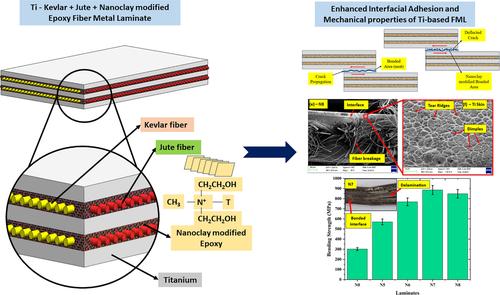当前位置:
X-MOL 学术
›
Polym. Compos.
›
论文详情
Our official English website, www.x-mol.net, welcomes your feedback! (Note: you will need to create a separate account there.)
Adhesion strength and mechanical properties of nanoclay modified hybrid kevlar/jute-epoxy fiber metal laminate
Polymer Composites ( IF 5.2 ) Pub Date : 2024-04-18 , DOI: 10.1002/pc.28449 Michael Roger Naveen 1 , Logesh Kamaraj 1 , Hariharasakthisudhan Ponnarengan 2
Polymer Composites ( IF 5.2 ) Pub Date : 2024-04-18 , DOI: 10.1002/pc.28449 Michael Roger Naveen 1 , Logesh Kamaraj 1 , Hariharasakthisudhan Ponnarengan 2
Affiliation

|
Delamination due to interfacial debonding between metal/composite is identified as a potential failure mechanism of fiber metal laminates (FML). In the present study, titanium based fiber metal laminate (Ti-FML) were fabricated using different wt% of nanoclay modified epoxy as adhesive. Kevlar/jute fibers bidirectionally woven mat was used to prepare the composite layer in the laminate. The laminates produced using compression molding techniques were studied for tensile, flexural, impact load bearing capacity and adhesive strength based on lap shear and peel test following ASTM standards. Lap shear adhesive strength of nanoclay modified epoxy was enhanced to 27 MPa and interlaminar peel strength was increased to 16.8 N/mm in the laminates, when the amount of nanoclay was increased to 8 wt%. Matrix crack deflection and crack bridging due to the presence of nanoclay was identified as potential mechanism for increasing the adhesive strength of epoxy. Enhanced adhesive strength resulted in improved mechanical characteristics of Ti-FML, exhibiting notable increases in tensile load bearing capacity at 15.5 kN, flexural peak load at 0.36 kN, and bending strength at 890 MPa, achieved with a 7 wt% increase in nanoclay content. Fiber breakage and plastic deformation of metal combinedly developed the failure deformation, load bearing and energy absorption capacity of the laminate. Hybridization of fibers kevlar/jute played a significant role in enhancing the energy absorption capacity of laminates. The developed material can find applications in aerospace structures, automotive components, and marine environments where superior mechanical performance and durability are essential.
中文翻译:

纳米粘土改性混合凯夫拉/黄麻-环氧纤维金属层压板的粘合强度和力学性能
由于金属/复合材料之间的界面脱粘而导致的分层被认为是纤维金属层压板(FML)的潜在失效机制。在本研究中,使用不同重量%的纳米粘土改性环氧树脂作为粘合剂制造了钛基纤维金属层压板(Ti-FML)。凯夫拉尔/黄麻纤维双向编织垫用于制备层压板中的复合层。根据 ASTM 标准,基于搭接剪切和剥离测试,研究了使用压缩成型技术生产的层压板的拉伸、弯曲、冲击承载能力和粘合强度。当纳米粘土的用量增加到8 wt%时,纳米粘土改性环氧树脂的搭接剪切粘合强度提高到27 MPa,层压板的层间剥离强度提高到16.8 N/mm。由于纳米粘土的存在而导致的基体裂纹偏转和裂纹桥接被认为是提高环氧树脂粘合强度的潜在机制。增强的粘合强度导致 Ti-FML 的机械特性得到改善,在 15.5 kN 的拉伸承载能力、0.36 kN 的弯曲峰值载荷和 890 MPa 的弯曲强度方面表现出显着增加,这是通过纳米粘土含量增加 7 wt% 实现的。纤维断裂和金属塑性变形共同发展了层合板的破坏变形、承载和能量吸收能力。凯夫拉纤维/黄麻纤维的杂交在增强层压板的能量吸收能力方面发挥了重要作用。所开发的材料可应用于航空航天结构、汽车零部件和海洋环境,这些环境中卓越的机械性能和耐用性至关重要。
更新日期:2024-04-18
中文翻译:

纳米粘土改性混合凯夫拉/黄麻-环氧纤维金属层压板的粘合强度和力学性能
由于金属/复合材料之间的界面脱粘而导致的分层被认为是纤维金属层压板(FML)的潜在失效机制。在本研究中,使用不同重量%的纳米粘土改性环氧树脂作为粘合剂制造了钛基纤维金属层压板(Ti-FML)。凯夫拉尔/黄麻纤维双向编织垫用于制备层压板中的复合层。根据 ASTM 标准,基于搭接剪切和剥离测试,研究了使用压缩成型技术生产的层压板的拉伸、弯曲、冲击承载能力和粘合强度。当纳米粘土的用量增加到8 wt%时,纳米粘土改性环氧树脂的搭接剪切粘合强度提高到27 MPa,层压板的层间剥离强度提高到16.8 N/mm。由于纳米粘土的存在而导致的基体裂纹偏转和裂纹桥接被认为是提高环氧树脂粘合强度的潜在机制。增强的粘合强度导致 Ti-FML 的机械特性得到改善,在 15.5 kN 的拉伸承载能力、0.36 kN 的弯曲峰值载荷和 890 MPa 的弯曲强度方面表现出显着增加,这是通过纳米粘土含量增加 7 wt% 实现的。纤维断裂和金属塑性变形共同发展了层合板的破坏变形、承载和能量吸收能力。凯夫拉纤维/黄麻纤维的杂交在增强层压板的能量吸收能力方面发挥了重要作用。所开发的材料可应用于航空航天结构、汽车零部件和海洋环境,这些环境中卓越的机械性能和耐用性至关重要。



























 京公网安备 11010802027423号
京公网安备 11010802027423号